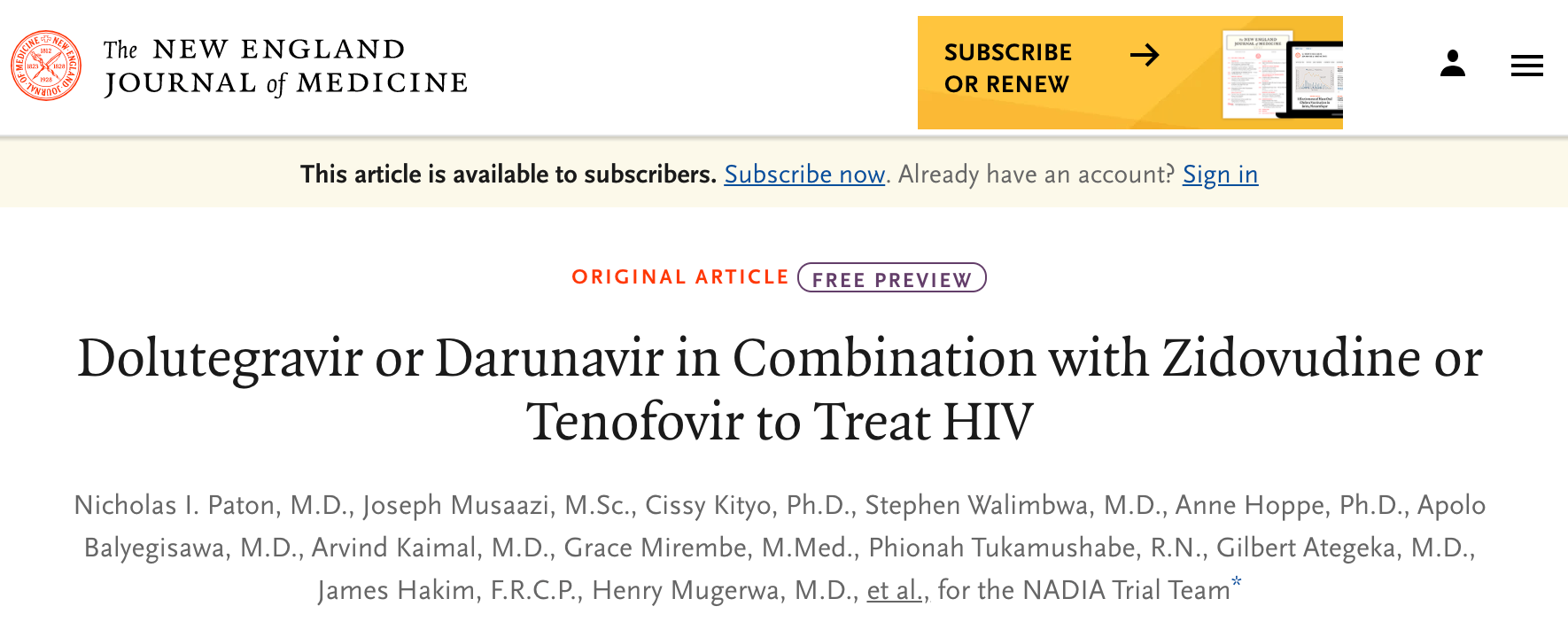NEJM:多替拉韦或达芦那韦联合齐多夫定或替诺福韦治疗HIV感染的比较的析因研究(NADIA研究)
时间:2021-07-27 23:39:24 热度:37.1℃ 作者:网络

世界卫生组织推荐将多替拉韦联合两种核苷逆转录酶抑制剂(NRTI)用于人类免疫缺陷病毒1型(HIV-1)感染的二线治疗。该治疗方案对于以下情况的疗效证据有限:因耐药而预计NRTI缺乏抗病毒活性时,以及推荐的将NRTI从替诺福韦换成齐多夫定。
方法
在一项2×2析因、开放标签、非劣效性试验中,我们将一线治疗失败(HIV-1病毒载量,≥1000 copies/mL)的患者随机分组,分别接受多替拉韦或利托那韦增强达芦那韦治疗,并且接受替诺福韦或齐多夫定治疗;所有患者均接受了拉米夫定治疗。主要结局是按照美国食品药品管理局快照算法,第48周的病毒载量<400 copies/mL(对于发生主要结局的患者百分比的组间差异,非劣效性界值为12个百分点)。
结果
我们在撒哈拉以南非洲地区的7个研究中心纳入了464例患者。在多替拉韦组90.2%的患者(212/235)和达芦那韦组91.7%的患者(210/229)(差异,-1.5%;95%置信区间[CI],-6.7~3.7;P=0.58;证明了多替拉韦的非劣效性,但未证明优效性)中,以及在替诺福韦组92.3%的患者(215/233)和齐多夫定组89.6%的患者(207/231)(差异,2.7%;95% CI,-2.6~7.9;P=0.32;证明了替诺福韦的非劣效性,但未证明优效性)中,我们观察到第48周的病毒载量<400 copies/mL。在预计NRTI缺乏抗病毒活性的患者亚组中,我们在多替拉韦组和达芦那韦组90%以上的患者中观察到病毒载量<400 copies/mL。在任何一项析因比较分析中,不良事件发生率均无显著组间差异。
结论
多替拉韦联合NRTI可有效治疗HIV-1感染患者,包括预计NRTI缺乏抗病毒活性的广泛NRTI耐药患者。作为二线治疗,替诺福韦不劣于齐多夫定。(由杨森公司资助;NADIA在ClinicalTrials.gov注册号为NCT03988452。)
Background The World Health Organization recommends dolutegravir with two nucleoside reverse-transcriptase inhibitors (NRTIs) for second-line treatment of human immunodeficiency virus type 1 (HIV-1) infection. Evidence is limited for the efficacy of this regimen when NRTIs are predicted to lack activity because of drug resistance, as well as for the recommended switch of an NRTI from tenofovir to zidovudine. MethodsIn a two-by-two factorial, open-label, noninferiority trial, we randomly assigned patients for whom first-line therapy was failing (HIV-1 viral load, ≥1000 copies per milliliter) to receive dolutegravir or ritonavir-boosted darunavir and to receive tenofovir or zidovudine; all patients received lamivudine. The primary outcome was a week 48 viral load of less than 400 copies per milliliter, assessed with the Food and Drug Administration snapshot algorithm (noninferiority margin for the between-group difference in the percentage of patients with the primary outcome, 12 percentage points).
Result
We enrolled 464 patients at seven sub-Saharan African sites. A week 48 viral load of less than 400 copies per milliliter was observed in 90.2% of the patients in the dolutegravir group (212 of 235) and in 91.7% of those in the darunavir group (210 of 229) (difference, −1.5 percentage points; 95% confidence interval [CI], −6.7 to 3.7; P=0.58; indicating noninferiority of dolutegravir, without superiority) and in 92.3% of the patients in the tenofovir group (215 of 233) and in 89.6% of those in the zidovudine group (207 of 231) (difference, 2.7 percentage points; 95% CI, −2.6 to 7.9; P=0.32; indicating noninferiority of tenofovir, without superiority). In the subgroup of patients with no NRTIs that were predicted to have activity, a viral load of less than 400 copies per milliliter was observed in more than 90% of the patients in the dolutegravir group and the darunavir group. The incidence of adverse events did not differ substantially between the groups in either factorial comparison.
Conclusions
Dolutegravir in combination with NRTIs was effective in treating patients with HIV-1 infection, including those with extensive NRTI resistance in whom no NRTIs were predicted to have activity. Tenofovir was noninferior to zidovudine as second-line therapy. (Funded by Janssen; NADIA ClinicalTrials.gov number, NCT03988452.) 原始出处: Nicholas I. Paton, Joseph Musaazi, Cissy Kityo, et al. Dolutegravir or Darunavir in Combination with Zidovudine or Tenofovir to Treat HIV. DOI: 10.1056/NEJMoa2101609

